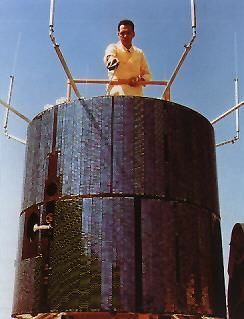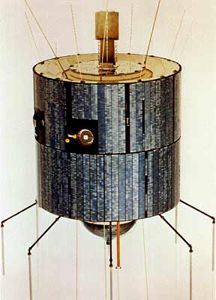
Home - Search - Browse - Alphabetic Index: 0- 1- 2- 3- 4- 5- 6- 7- 8- 9
A- B- C- D- E- F- G- H- I- J- K- L- M- N- O- P- Q- R- S- T- U- V- W- X- Y- Z
ATS-1
 ATS-1 Credit: NASA |
AKA: Applications Technology Satellite. Status: Operational 1966. First Launch: 1966-12-07. Last Launch: 1966-12-07. Number: 1 . Gross mass: 352 kg (776 lb). Height: 1.30 m (4.20 ft).
Its VHF experiment tested the ability to act as a link between ground stations and aircraft, demonstrated collection of meteorological data from remote terminals, and evaluated the feasibility of using VHF signals for navigation.
ATS-1 transmitted educational programs and provided health, research, and community services to the US and several Pacific island countries, including the Cook, Mariana, Marshall and Caroline Islands, West and American Samoa, Melanesia, New Zealand, and Australia. The mission also provided the first full-Earth cloud cover images.
The spin stabilized spacecraft had an aluminum structure, with a drum solar array providing 180W BOL. Other systems included 2 6 Ah NiCd batteries, a hydrazine stationkeeping system, a nutation damper, two sun sensors, and two accelerometers. Payloads included ion detectors, spectrometers, a camera, a C-band communications experiment (also used for international television broadcasts) and a VHF communications package
More at: ATS-1.
Family: Communications technology sat, Geosynchronous orbit, Technology. Country: USA. Launch Vehicles: Atlas, Atlas SLV-3 Agena D. Projects: ATS. Launch Sites: Cape Canaveral, Cape Canaveral LC12. Agency: NASA, NSF, Hughes. Bibliography: 2, 278, 279, 3583, 3584, 6, 6369, 12123.
 | ATS 1 Credit: Manufacturer Image |
 | ATS-1 Credit: Manufacturer Image |
1966 December 7 - . 02:12 GMT - . Launch Site: Cape Canaveral. Launch Complex: Cape Canaveral LC12. LV Family: Atlas. Launch Vehicle: Atlas SLV-3 Agena D.
- ATS 1 - .
Payload: ATS B. Mass: 352 kg (776 lb). Nation: USA.
Agency: NASA Greenbelt.
Program: ATS.
Class: Technology.
Type: Communications technology satellite. Spacecraft Bus: HS 306.
Spacecraft: ATS-1.
Completed Operations Date: 1985-04-01 . USAF Sat Cat: 2608 . COSPAR: 1966-110A. Apogee: 35,783 km (22,234 mi). Perigee: 35,728 km (22,200 mi). Inclination: 12.50 deg. Period: 1,434.50 min.
Applications Technology Satellite; communications and meteorological experiments. Positioned in geosynchronous orbit over the Americas at 151 deg W in 1966-1968?; over the Americas at 149 deg W in 1968-1982; over the Pacific Ocean 170 deg E in 1982-1985 As of 3 September 2001 located at 167.30 deg E drifting at 0.065 deg E per day. As of 2007 Mar 9 located at 59.28W drifting at 0.332E degrees per day.
Back to top of page
Home - Search - Browse - Alphabetic Index: 0- 1- 2- 3- 4- 5- 6- 7- 8- 9
A- B- C- D- E- F- G- H- I- J- K- L- M- N- O- P- Q- R- S- T- U- V- W- X- Y- Z
© 1997-2019 Mark Wade - Contact
© / Conditions for Use